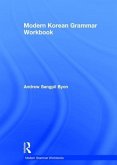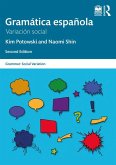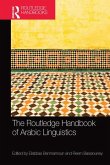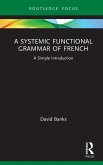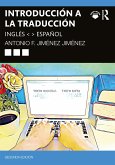- Gebundenes Buch
- Merkliste
- Auf die Merkliste
- Bewerten Bewerten
- Teilen
- Produkt teilen
- Produkterinnerung
- Produkterinnerung
Loanwords and Japanese Identity: Inundating or Absorbed? provides an in-depth examination of public discussions on lexical borrowing in the Japanese language.
Andere Kunden interessierten sich auch für
![Modern Korean Grammar Workbook Modern Korean Grammar Workbook]() Andrew Sangpil ByonModern Korean Grammar Workbook53,99 €
Andrew Sangpil ByonModern Korean Grammar Workbook53,99 €![Modern Korean Grammar Workbook Modern Korean Grammar Workbook]() Andrew Sangpil ByonModern Korean Grammar Workbook197,99 €
Andrew Sangpil ByonModern Korean Grammar Workbook197,99 €![Gramática española Gramática española]() Kim PotowskiGramática española195,99 €
Kim PotowskiGramática española195,99 €![The Routledge Handbook of Arabic Linguistics The Routledge Handbook of Arabic Linguistics]() The Routledge Handbook of Arabic Linguistics64,99 €
The Routledge Handbook of Arabic Linguistics64,99 €![A Systemic Functional Grammar of French A Systemic Functional Grammar of French]() David BanksA Systemic Functional Grammar of French85,99 €
David BanksA Systemic Functional Grammar of French85,99 €![Introducción a la Traducción Introducción a la Traducción]() Antonio F Jiménez JiménezIntroducción a la Traducción87,99 €
Antonio F Jiménez JiménezIntroducción a la Traducción87,99 €![The Arabic-English Translator as Photographer The Arabic-English Translator as Photographer]() Ali AlmannaThe Arabic-English Translator as Photographer195,99 €
Ali AlmannaThe Arabic-English Translator as Photographer195,99 €-
-
-
Loanwords and Japanese Identity: Inundating or Absorbed? provides an in-depth examination of public discussions on lexical borrowing in the Japanese language.
Hinweis: Dieser Artikel kann nur an eine deutsche Lieferadresse ausgeliefert werden.
Hinweis: Dieser Artikel kann nur an eine deutsche Lieferadresse ausgeliefert werden.
Produktdetails
- Produktdetails
- Verlag: Taylor & Francis
- Seitenzahl: 196
- Erscheinungstermin: 28. Februar 2023
- Englisch
- Abmessung: 234mm x 156mm x 13mm
- Gewicht: 463g
- ISBN-13: 9781032054261
- ISBN-10: 1032054263
- Artikelnr.: 66712235
- Verlag: Taylor & Francis
- Seitenzahl: 196
- Erscheinungstermin: 28. Februar 2023
- Englisch
- Abmessung: 234mm x 156mm x 13mm
- Gewicht: 463g
- ISBN-13: 9781032054261
- ISBN-10: 1032054263
- Artikelnr.: 66712235
Naoko Hosokawa is a postdoctoral fellow at Tokyo College, University of Tokyo. After obtaining a doctoral degree from the Faculty of Oriental Studies, University of Oxford, she worked at the School for Advanced Studies in the Social Sciences (EHESS), the European University Institute, as well as the University of Strasbourg, and took the current position in 2020. Her research focuses on the relationship between language and identity through the examination of media discourse. Her recent publications include "From reality to discourse: Analysis of the 'refugee' metaphor in the Japanese news media" in Journal of Multicultural Discourses as well as "The New Wild: Thinking Linguistic Globalization through the Ecology of Species" in The Manifold Nature of Bilingual Education.
Chapter 1: Loanwords in Japan
1.1 Western Loanwords and Japan Today
1.2 What are Gairaigo and Katakanago?
1.3 Gairaigo Controversies
1.4 Key Questions and Focal Points
Chapter 2: For or Against?
2.1 Language and Identity
2.2: Public Opinions
2.3: Advantages and Disadvantages
2.4: Why the Polemic?
2.5: Gairaigo and Nihongo Dichotomy
2.6: Nihongo and Kokugo
Chapter 3: Inundating or Absorbed?
3.1: Textual Data
3.2: Time Frame
3.3: Method of Analysis
3.4: Recurrent Verbs
3.5: Implications
Chapter 4: Japanese or Foreign?
4.1: Nihongo, the Japanese language, and Gairaigo, Loanwords
4.2: Analysis
4.3: Summary
Chapter 5: What Kind of Loanwords?
5.1: Loanwords as 'Outside Within'
5.2: Metaphors
5.3: Contrasts
5.4: Evolution of Japanese Identities
Chapter 6: Loanwords and Identity in the Age of Diversity
6.1: French Discourse on Loanwords
6.2: Comparative Observations
6.3: Use of Katakana for Japanese Loanwords Abroad
6.4: From the 'Outside Within' to the 'New Wild'
1.1 Western Loanwords and Japan Today
1.2 What are Gairaigo and Katakanago?
1.3 Gairaigo Controversies
1.4 Key Questions and Focal Points
Chapter 2: For or Against?
2.1 Language and Identity
2.2: Public Opinions
2.3: Advantages and Disadvantages
2.4: Why the Polemic?
2.5: Gairaigo and Nihongo Dichotomy
2.6: Nihongo and Kokugo
Chapter 3: Inundating or Absorbed?
3.1: Textual Data
3.2: Time Frame
3.3: Method of Analysis
3.4: Recurrent Verbs
3.5: Implications
Chapter 4: Japanese or Foreign?
4.1: Nihongo, the Japanese language, and Gairaigo, Loanwords
4.2: Analysis
4.3: Summary
Chapter 5: What Kind of Loanwords?
5.1: Loanwords as 'Outside Within'
5.2: Metaphors
5.3: Contrasts
5.4: Evolution of Japanese Identities
Chapter 6: Loanwords and Identity in the Age of Diversity
6.1: French Discourse on Loanwords
6.2: Comparative Observations
6.3: Use of Katakana for Japanese Loanwords Abroad
6.4: From the 'Outside Within' to the 'New Wild'
Chapter 1: Loanwords in Japan
1.1 Western Loanwords and Japan Today
1.2 What are Gairaigo and Katakanago?
1.3 Gairaigo Controversies
1.4 Key Questions and Focal Points
Chapter 2: For or Against?
2.1 Language and Identity
2.2: Public Opinions
2.3: Advantages and Disadvantages
2.4: Why the Polemic?
2.5: Gairaigo and Nihongo Dichotomy
2.6: Nihongo and Kokugo
Chapter 3: Inundating or Absorbed?
3.1: Textual Data
3.2: Time Frame
3.3: Method of Analysis
3.4: Recurrent Verbs
3.5: Implications
Chapter 4: Japanese or Foreign?
4.1: Nihongo, the Japanese language, and Gairaigo, Loanwords
4.2: Analysis
4.3: Summary
Chapter 5: What Kind of Loanwords?
5.1: Loanwords as 'Outside Within'
5.2: Metaphors
5.3: Contrasts
5.4: Evolution of Japanese Identities
Chapter 6: Loanwords and Identity in the Age of Diversity
6.1: French Discourse on Loanwords
6.2: Comparative Observations
6.3: Use of Katakana for Japanese Loanwords Abroad
6.4: From the 'Outside Within' to the 'New Wild'
1.1 Western Loanwords and Japan Today
1.2 What are Gairaigo and Katakanago?
1.3 Gairaigo Controversies
1.4 Key Questions and Focal Points
Chapter 2: For or Against?
2.1 Language and Identity
2.2: Public Opinions
2.3: Advantages and Disadvantages
2.4: Why the Polemic?
2.5: Gairaigo and Nihongo Dichotomy
2.6: Nihongo and Kokugo
Chapter 3: Inundating or Absorbed?
3.1: Textual Data
3.2: Time Frame
3.3: Method of Analysis
3.4: Recurrent Verbs
3.5: Implications
Chapter 4: Japanese or Foreign?
4.1: Nihongo, the Japanese language, and Gairaigo, Loanwords
4.2: Analysis
4.3: Summary
Chapter 5: What Kind of Loanwords?
5.1: Loanwords as 'Outside Within'
5.2: Metaphors
5.3: Contrasts
5.4: Evolution of Japanese Identities
Chapter 6: Loanwords and Identity in the Age of Diversity
6.1: French Discourse on Loanwords
6.2: Comparative Observations
6.3: Use of Katakana for Japanese Loanwords Abroad
6.4: From the 'Outside Within' to the 'New Wild'


